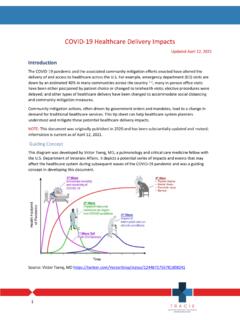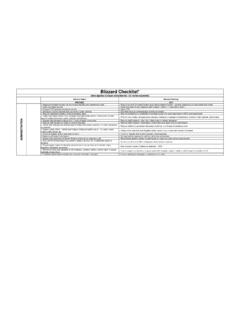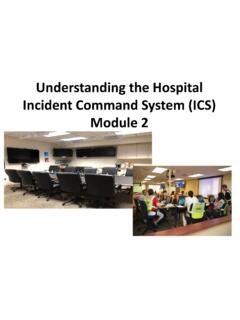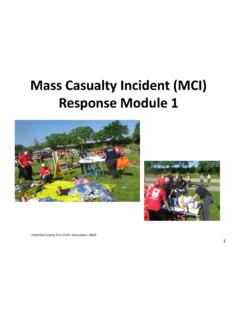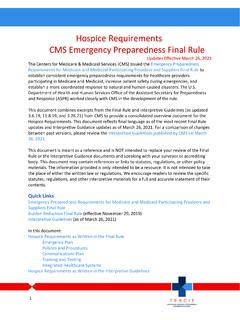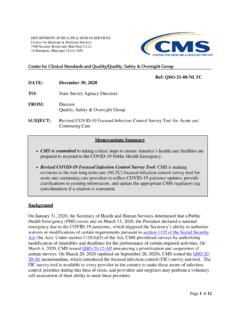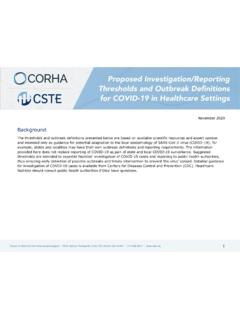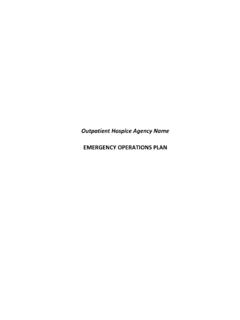Transcription of Long Term Care Requirements - United States Department of ...
1 TRACI E long Term care Requirements CMS emergency preparedness Final Rule Updates Effective March 26, 2021 The Centers for Medicare & Medicaid Services (CMS) issued the emergency preparedness Requirements for Medicare and Medicaid Participating Providers and Suppliers Final Rule to establish consistent emergency preparedness Requirements for healthcare providers participating in Medicare and Medicaid, increase patient safety during emergencies, and establish a more coordinated response to natural and human-caused disasters. The Department of Health and Human Services Office of the Assistant Secretary for preparedness and Response (ASPR) worked closely with CMS in the development of the rule. This document combines excerpts from the Final Rule and Interpretive Guidelines (as updated , , and ) from CMS to provide a consolidated overview document for the long Term care Requirements . This document reflects final language as of the most recent Final Rule updates and Interpretive Guidance updates as of March 26, 2021.
2 For a comparison of changes between past versions, please review the Interpretive Guidelines published by CMS on March 26, 2021. This document is meant as a reference and is NOT intended to replace your review of the Final Rule or the Interpretive Guidance documents and speaking with your surveyor or accrediting body. This document may contain references or links to statutes, regulations, or other policy materials. The information provided is only intended to be a resource. It is not intended to take the place of either the written law or regulations. We encourage readers to review the specific statutes, regulations, and other interpretive materials for a full and accurate statement of their contents. Quick Links emergency preparedness Requirements for Medicare and Medicaid Participating Providers and Suppliers Final Rule Burden Reduction Final Rule (effective November 29, 2019) Interpretive Guidelines (as of March 26, 2021) Interpretive Guidelines Surveyor Cheat Sheet In this document: LTC Requirements as Written in the Final Rule emergency Plan Policies and Procedures Communications Plan Training and Testing emergency and Standby Power Systems 1 TRACI E Integrated Healthcare Systems LTC Requirements as Written in the Interpretive Guidelines 2 TRACI E long Term care Requirements as Written in the Final Rule and as amended by 2019 Burden Reduction (November 2019) The following excerpt is taken from page 64030 of the Final Rule, accessible directly by this link: and Medicare and Medicaid Programs.
3 Regulatory Provisions To Promote Program Efficiency, Transparency, and Burden Reduction; Fire Safety Requirements for Certain Dialysis Facilities; Hospital and Critical Access Hospital (CAH) Changes To Promote Innovation, Flexibility, and Improvement in Patient care published September 30, 2019 and effective November 29, 2019 PART 483 Requirements FOR States AND long TERM care FACILITIES 19. The authority citation for part 483 continues to read as follows: Authority: Secs. 1102, 1128I, 1819, 1871 and 1919 of the Social Security Act (42 1302, 1320a-7, 1395i, 1395hh and 1396r). 20. Add to read as follows: emergency preparedness . The LTC facility must comply with all applicable Federal, State and local emergency preparedness Requirements . The LTC facility must establish and maintain an emergency preparedness program that meets the Requirements of this section. The emergency preparedness program must include, but not be limited to, the following elements: (a) emergency plan.
4 The LTC facility must develop and maintain an emergency preparedness plan that must be reviewed, and updated at least annually. The plan must do all of the following: 1) Be based on and include a documented, facility-based and community-based risk assessment, utilizing an all-hazards approach, including missing residents. 2) Include strategies for addressing emergency events identified by the risk assessment. 3) Address resident population, including, but not limited to, persons at-risk; the type of services the LTC facility has the ability to provide in an emergency ; and continuity of operations, including delegations of authority and succession plans. 4) Include a process for cooperation and collaboration with local, tribal, regional, State, or Federal emergency preparedness officials' efforts to maintain an integrated response during a disaster or emergency situation. (b) Policies and procedures. The LTC facility must develop and implement emergency preparedness policies and procedures, based on the emergency plan set forth in paragraph (a) of this section, risk assessment at paragraph (a)(1) of this section, and the communication plan 3 TRACI E at paragraph (c) of this section.
5 The policies and procedures must be reviewed and updated at least annually. At a minimum, the policies and procedures must address the following: 1) The provision of subsistence needs for staff and residents, whether they evacuate or shelter in place, include, but are not limited to the following: i. Food, water, medical, and pharmaceutical supplies. ii. Alternate sources of energy to maintain a. Temperatures to protect resident health and safety and for the safe and sanitary storage of provisions; b. emergency lighting; c. Fire detection, extinguishing, and alarm systems; and d. Sewage and waste disposal. 2) A system to track the location of on-duty staff and sheltered residents in the LTC facility's care during and after an emergency . If on-duty staff and sheltered residents are relocated during the emergency , the LTC facility must document the specific name and location of the receiving facility or other location. 3) Safe evacuation from the LTC facility, which includes consideration of care and treatment needs of evacuees; staff responsibilities; transportation; identification of evacuation location(s); and primary and alternate means of communication with external sources of assistance.
6 4) A means to shelter in place for residents, staff, and volunteers who remain in the LTC facility. 5) A system of medical documentation that preserves resident information, protects confidentiality of resident information, and secures and maintains the availability of records. 6) The use of volunteers in an emergency or other emergency staffing strategies, including the process and role for integration of State or Federally designated health care professionals to address surge needs during an emergency . 7) The development of arrangements with other LTC facilities and other providers to receive residents in the event of limitations or cessation of operations to maintain the continuity of services to LTC residents. 8) The role of the LTC facility under a waiver declared by the Secretary, in accordance with section 1135 of the Act, in the provision of care and treatment at an alternate care site identified by emergency management officials. (c) Communication plan. The LTC facility must develop and maintain an emergency preparedness communication plan that complies with Federal, State, and local laws and must be reviewed and updated at least annually.
7 The communication plan must include all of the following: 1) Names and contact information for the following: i. Staff. 4 TRACI E ii. Entities providing services under arrangement. iii. Residents' physicians. iv. Other [facilities]. v. Volunteers. 2) Contact information for the following: i. Federal, State, tribal, regional, or local emergency preparedness staff. ii. The State Licensing and Certification Agency. iii. The Office of the State long -Term care Ombudsman. iv. Other sources of assistance. 3) Primary and alternate means for communicating with the following: i. LTC facility's staff. ii. Federal, State, tribal, regional, or local emergency management agencies. 4) A method for sharing information and medical documentation for residents under the LTC facility's care , as necessary, with other health care providers to maintain the continuity of care . 5) A means, in the event of an evacuation, to release resident information as permitted under 45 CFR (b)(1)(ii).
8 6) A means of providing information about the general condition and location of residents under the facility's care as permitted under 45 CFR (b)(4). 7) A means of providing information about the LTC facility's occupancy, needs, and its ability to provide assistance, to the authority having jurisdiction or the Incident Command Center, or designee. 8) A method for sharing information from the emergency plan that the facility has determined is appropriate with residents and their families or representatives. (d) Training and testing. The LTC facility must develop and maintain an emergency preparedness training and testing program that is based on the emergency plan set forth in paragraph (a) of this section, risk assessment at paragraph (a)(1) of this section, policies and procedures at paragraph (b) of this section, and the communication plan at paragraph (c) of this section. The training and testing program must be reviewed and updated at least annually. 1) Training program.
9 The LTC facility must do all of the following: i. Initial training in emergency preparedness policies and procedures to all new and existing staff, individuals providing services under arrangement, and volunteers, consistent with their expected roles. ii. Provide emergency preparedness training at least annually. iii. Maintain documentation of all emergency preparedness training. iv. Demonstrate staff knowledge of emergency procedures. 2) Testing. The LTC facility must conduct exercises to test the emergency plan at least twice per year, including unannounced staff drills using the emergency procedures. The LTC facility must do the following: 5 TRACI E i. Participate in an annual full-scale exercise that is community-based; or a. When a community-based exercise is not accessible, conduct an annual individual, facility-based functional exercise. b. If the LTC facility experiences an actual natural or man-made emergency that requires activation of the emergency plan, the LTC facility is exempt from engaging its next required full-scale community-based or individual, facility-based functional exercise following the onset of the actual event.
10 Ii. Conduct an additional exercise that may include, but is not limited to the following: a. A second full-scale exercise that is community-based or an individual, facility-based functional exercise. b. A mock disaster drill; or c. A tabletop exercise or workshop that is led by a facilitator includes a group discussion, using a narrated, clinically-relevant emergency scenario, and a set of problem statements, directed messages, or prepared questions designed to challenge an emergency plan. iii. Analyze the LTC facility's response to and maintain documentation of all drills, tabletop exercises, and emergency events, and revise the LTC facility's emergency plan, as needed. (e) emergency and standby power systems. The LTC facility must implement emergency and standby power systems based on the emergency plan set forth in paragraph (a) of this section. 1) emergency generator location. The generator must be located in accordance with the location Requirements found in the Health care Facilities Code (NFPA 99 and Tentative Interim Amendments TIA 12-2, TIA 12-3, TIA 12-4, TIA 12-5, and TIA 12-6), Life Safety Code (NFPA 101 and Tentative Interim Amendments TIA 12-1, TIA 12-2, TIA 12-3, and TIA 12-4), and NFPA 110, when a new structure is built or when an existing structure or building is renovated.

